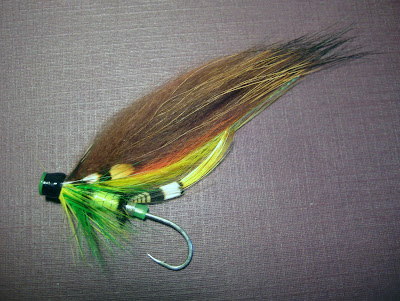Thirteen years ago I purchased my first two hand rod. A pre-owned Loomis 14' GL for a 9 weight line. This became my rod of choice for fishing from a 26' Gaspe Boat on the big rivers of the Gaspe Peninsula of Quebec. The long rod not only made shooting head overhead casts, but conveniently passed over my guides head sitting in the stern. The guides said I made their job easier because I covered two drops at a time making boat position changes less often. I was also able to continue each swing to the opposite side of the boat and cover the all important dangle directly below.
It was a few years later that I started to learn traditional as well as modern two hand casts. I now feel very confident fishing for Atlantic Salmon and Steelhead with two hands. Traditional Spey, Scandi, Skagit and Salter. I own a nice collection of Salmon and Switch rods that suit my fishing needs.
Six years ago I built a 5 weight switch rod for use on the larger trout rivers in Northern Maine and New Hampshire. These are big waters where currents create deep pockets in heavy flows and having a longer rod offers extra distance from two hand casting techniques. Along with this greater distance is the ability to control your line through pockets by holding the rod high and reducing drag. This rod, even though only a 5 weight, works well with a light 275 grain Skagit and short sinking poly leaders for West Coast style swinging. As we all know, fishing success is about keeping your fly in the water and learning how to use a two hand set up will give you, at a minimum, 15% more fly in the water time. There is no back casting or any multi roll casts to get your line out where you want it to be.
In addition, I wanted the ability to change from nymphing to swinging quickly. I am always thinking of ways to limit the quantity of gear that must be carried for an entire day. This was achieved with the creation of a short head line that will accept indicator and weight and converts quickly to a short head Spey line with the addition of a floating tip. I also use this same short head line with sinking poly leaders. With this set up I carry one rod, reel, backing, line and the tips necessary for various changes that will satisfy all scenarios except one. The dry fly.
Because my switch rod is 10' 4", I can cast with one had with ease. Carrying a full floating line for dry fly fishing requires a second spool. This is the quickest and most efficient way to make the change.
As the season progresses, I do go to a full dry fly set up on a single hand 4 weight. The waters get slower, the fish are looking up and the fun of the lighter presentation is always desired at those times. For most of the year, I have found that nothing can take the place of the two hand set up. This also applies to all my nymphing for Steelhead with an 8 weight switch.
For some strange reason the light weight two hand rod gets a great deal of resistance. I hear that people are "set in their ways" and "what has been is good enough" or "you will never get me to do that". If there were one thing, and one thing only, that I could make you do, it would be to get a switch rod and learn the many advantages it offers.
William
 In days gone by rivers had individual style to their flies. Dee Flies and Spey Flies are very different in materials and construction right down to the style of hook. The headwaters of these two rivers are so close together that you would think there would have been more commonality. Take New Brunswick and Quebec as a model. The rivers are very different and so were the flies but if you were to check the fly boxes on the Gaspe you might just find a few Green machines in the mix. You will also find creations that were designed for the Gaula as well. Soft hair tied in a reverse full bodied style is all the rage in spring and fall no matter where you are.
In days gone by rivers had individual style to their flies. Dee Flies and Spey Flies are very different in materials and construction right down to the style of hook. The headwaters of these two rivers are so close together that you would think there would have been more commonality. Take New Brunswick and Quebec as a model. The rivers are very different and so were the flies but if you were to check the fly boxes on the Gaspe you might just find a few Green machines in the mix. You will also find creations that were designed for the Gaula as well. Soft hair tied in a reverse full bodied style is all the rage in spring and fall no matter where you are.








